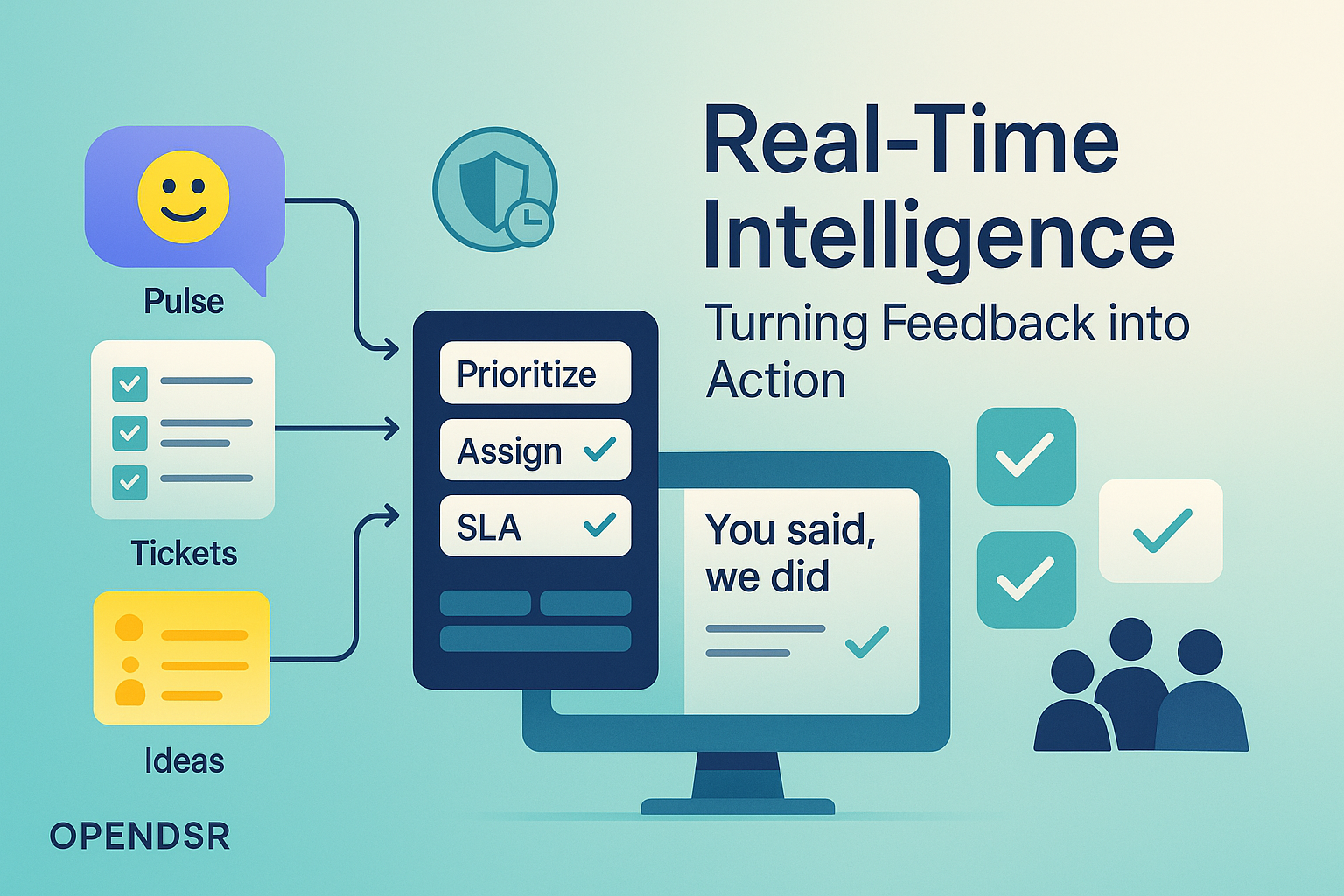
Real-time Intelligence: Turning Feedback into Action
How to listen continuously, decide faster, and prove impact—without burning out your teams
Most organizations are drowning in feedback yet thirsty for insight. Surveys, town halls, help-desk tickets, chat messages, exit interviews, Glassdoor reviews, LMS comments, even emoji reactions—signals pour in from every direction. The problem isn’t hearing; it’s acting with speed and confidence. Real-time intelligence (RTI) is the operating discipline that converts noisy, multi-channel feedback into prioritized actions, closed loops, and measurable business outcomes.
This article lays out a practical blueprint for building RTI into your employee experience (EX) program—so you don’t just “collect feedback”; you move the needle. You’ll learn how to design your data flows, standardize tagging, triage effectively, assign owners, communicate decisions, and track impact. We’ll connect each step to the OPENDSR method (Observe → Prioritize → Envision → Navigate → Design → Systematize → Refine) so your efforts scale beyond one-off wins.
Why speed matters (and what “real-time” really means)
“Real-time” doesn’t always mean milliseconds. In EX, it means the latency between a signal and a meaningful response is short enough to preserve trust and prevent value leakage. Practical targets:
-
Acknowledgment latency (TTA): within 24 hours for most channels; within 1 hour for high-severity signals (e.g., psychological safety, safety incidents, harassment).
-
Time to first action (TTFA): 3–5 business days for operational fixes; 10–15 days for cross-functional items; longer for policy changes, with interim comms.
-
Close-the-loop rate: 80% of items get a visible response (“You said, we did / we’re doing / here’s why not”).
Speed signals respect. When employees see timely acknowledgment and action, participation rises, noise drops, and sentiment improves—even when the answer is “not now.”
From noise to signal: an RTI architecture you can actually run
Think of RTI as a simple, resilient pipeline:
-
Ingest – Pull signals from core sources:
-
Pulse and lifecycle surveys
-
Help-desk/HR tickets
-
Collaboration tools (Teams/Slack channels, moderated)
-
EX assistant chat, suggestion boxes, Idea Center
-
Exit/Stay interviews, manager 1:1 notes (structured fields)
-
Policy/Q&A portals and comments
-
-
Normalize – Standardize fields (timestamp, source, location, team, persona). Strip PII when not needed; hash IDs for trend analysis. Ensure consent and retention rules are applied.
-
Enrich – Add intelligence:
-
Topic tags (taxonomy aligned to EX pillars)
-
Sentiment and emotion scores
-
Severity (risk, safety, compliance) vs Irritant level (friction cost)
-
Reach (how many people affected) and Recurrence
-
-
Route – Auto-assign categories to action queues (IT, Facilities, HR Ops, Comms, L&D, DEI, Security). Set SLAs and owners. Escalate high-risk items.
-
Act & Learn – Capture actions taken, outcomes, and employee follow-up feedback. Feed learnings back to tagging, playbooks, and prioritization rules.
Keep it boring. Resist the urge for fragile complexity. A small set of well-named tags, clear queues, and firm SLAs beats a fancy model no one trusts.
The 5-Step Action Loop
Use this loop daily. It’s OPENDSR-compatible and easy to teach:
-
Listen (Observe)
Aggregate signals continuously. Ensure channel diversity—don’t rely only on surveys. -
Label (Prioritize)
Apply topic + severity + reach tags. Auto-tag 80%; human-review the rest. -
Learn (Envision/Navigate)
Ask “What’s the smallest action that reduces the most friction fastest?” Draft options with pros/cons. -
Launch (Design/Systematize)
Assign owner + deadline, implement fix/experiment, and post a short “You said, we did” update. -
Loop (Refine)
Measure result (sentiment shift, time saved, adoption), update the playbook, and retire the item.
A pragmatic prioritization model
Create a simple score that ranks items objectively. Example:
Priority Score = (Severity × 3) + (Reach × 2) + (Recurrence × 1) − (Effort × 1)
-
Severity (1–5): risk to safety, well-being, ethical/legal exposure
-
Reach (1–5): number/percentage of people impacted
-
Recurrence (1–5): frequency pattern over 30–90 days
-
Effort (1–5): complexity, dependencies, cost/time
Use cut-offs:
-
P1 (15+): fix now; executive visibility
-
P2 (11–14): commit this sprint
-
P3 (≤10): backlog, bundle into themes or quarterly improvements
Action types that keep momentum
-
Quick wins (0–2 weeks): micro-policies, FAQ updates, small UI tweaks, signage, meeting norms, short how-to videos.
-
Operational fixes (2–6 weeks): process clarifications, approval flow changes, routing rules, access permissions.
-
Experiments (2–8 weeks): A/B a new form, pilot a tool, try a new shift pattern.
-
Systemic changes (6–16 weeks): policy updates, role redesign, vendor changes, cross-functional workflows.
-
Narrative actions (same day): acknowledge, explain constraints, set expectations. Clear, honest comms prevent churn while longer fixes mature.
Dashboards that drive action (not just pretty charts)
Build one Actionability Dashboard that a frontline manager can use:
-
Today’s queue: P1/P2 items by owner and SLA clock
-
Hotspots: Top themes by severity × reach (map/table)
-
Time-to-acknowledge (TTA): median by channel
-
Time-to-first-action (TTFA): trend and by team
-
Close-the-loop rate: percentage with visible response
-
Sentiment shift: pre/post action on that theme
-
Reopen rate: items reopened within 30 days
-
Volume & participation: signals by channel and cohort
-
“You said, we did” feed: shareable updates for trust
If a metric doesn’t change behavior, drop it.
Operating rhythm: the rituals that make RTI real
-
Daily 15-min triage: Small cross-functional crew reviews P1/P2, sets owners, clears blockers.
-
Weekly 30-min ops review: Theme trends, SLA health, top actions shipped; spotlight one quick win story.
-
Monthly governance: Policy-level changes, systemic themes, resource trade-offs, and ethics/privacy reviews.
-
Quarterly readout to leadership: Impact report (time saved, sentiment up, attrition down in target cohorts), plus next quarter’s focus.
Assign a named EX Operations Lead as the conductor. Publish a simple RACI: EX Ops (R), Functional Owner (A), Data/IT (C), Comms (C), Legal/ER (C as needed).
Data ethics and trust by design
Real-time doesn’t justify reckless. Bake in:
-
Consent & transparency: Say what you collect, why, and for how long. Offer opt-outs where feasible.
-
Minimum necessary: Don’t store free-form PII unless essential.
-
Anonymity where possible: Aggregate at team size thresholds to avoid singling out.
-
Sensitive topics routing: Secure queues with tighter access and faster SLAs.
-
Bias checks: Periodic audits of tagging and sentiment by cohort (gender, tenure, location) to catch skew.
-
Retention discipline: Clear, automated deletion windows.
Trust is a feature. Design it like one.
Day-in-the-life: an EX Ops center for one medium-sized company
-
08:30 – Overnight signals show a spike in “VPN timeout” complaints (Severity 3, Reach high). TTA within 30 minutes: EX Ops acknowledges, IT owner assigned.
-
10:00 – Quick fix pushes new VPN client config + short explainer video. “You said, we did” goes live in Teams channel.
-
13:00 – Pulse comments flag meeting fatigue on Wednesdays. Comms drafts a meeting-lite Wednesday pilot for two weeks.
-
15:30 – Three safety-related comments from a warehouse location escalate to P1; Facilities dispatch checks, HR schedules a listening huddle same day.
-
17:00 – Dashboard shows TTFA median down from 4.2 to 2.9 days in 30 days; sentiment on “IT Access” theme up 11 points.
Not glamorous—just consistent throughput and visible outcomes.
Mapping RTI to OPENDSR
-
Observe: Multi-channel ingest + listening posts at key “moments that matter.”
-
Prioritize: Scoring model (severity, reach, recurrence, effort) + SLA queues.
-
Envision: Draft candidate actions; choose smallest effective move first.
-
Navigate: Sequence actions, align owners, remove cross-team blockers.
-
Design: Implement fixes/experiments with clear acceptance criteria.
-
Systematize: Create repeatable playbooks, auto-routing, and templates.
-
Refine: Measure impact, codify learnings, prune metrics/tags that don’t help.
The playbooks you’ll reuse forever
-
Acknowledgment micro-playbook (all channels)
-
Template: “Thanks for raising this. Owner: name. First update by date. Here’s what we’re checking…”
-
Goal: TTA 24 hours (or 1 hour for P1).
-
-
Theme triage playbook
-
If Severity ≥4 or Reach ≥4 → P1; else P2/P3 paths.
-
Auto-assign to queue; notify functional leader; set SLA.
-
-
“You said, we did” comms playbook
-
3 lines max: Problem → Action → Expected benefit/timeframe.
-
Visual tag for each pillar (Leadership & Culture, Communication, Tech & Tools, etc.).
-
-
Experiment playbook
-
Hypothesis, success metric, sample size/duration, decision rule.
-
End with a crisp “roll/iterate/retire” call.
-
-
Post-action validation playbook
-
Re-survey impacted cohort or sample; compare sentiment and friction KPIs.
-
Log before/after analytics and learning notes.
-
Metrics that prove you’re not just busy
-
Speed: TTA, TTFA, Time-to-Resolution (TTR) by queue and severity
-
Throughput: Items triaged, shipped, reopened, per week
-
Quality: Reopen rate, deflection rate (questions answered by knowledge base), successful experiment rate
-
Participation: Unique contributors, repeat contributors, channel distribution
-
Outcome: Sentiment shift per theme, time saved (hours/week), reduction in failure demand (tickets avoided), retention risk delta for targeted cohorts
-
Trust: % items with visible responses, “I feel heard” score, view/click rate on “You said, we did”
Tie at least one metric to dollars (time saved × blended hourly rate; attrition avoided × replacement cost).
Common pitfalls (and how to dodge them)
-
Analysis paralysis: Too many tags, no accountability. Fix: Start with 12–18 tags, evolve quarterly.
-
Survey myopia: Ignoring operational data. Fix: Blend surveys with ticketing and collaboration signals.
-
Opaque comms: Silent work kills trust. Fix: Publish a weekly “Top 5 fixes shipped.”
-
Heroics over systems: One superstar triager. Fix: Write playbooks, rotate roles, cross-train.
-
Privacy oversights: Over-collecting PII. Fix: Minimize fields, aggregate wherever possible, audit access.
A simple maturity model
-
Ad-hoc: Manual reading of surveys; sporadic fixes; no SLAs or owners.
-
Repeatable: Basic tags, shared inbox, weekly triage; some SLAs; “You said, we did” begins.
-
Managed: Auto-tagging, routing, dashboards, daily triage; priority model enforced; outcomes tracked.
-
Optimized: Cross-system automation, experiment muscle, cost/time impact tied to finance; quarterly portfolio planning.
-
Institutionalized: Feedback-to-action embedded in all ops; leaders measured on close-the-loop and friction removal; RTI informs strategy.
Aim for Level 3 in 90 days; the rest will follow.
The 30-60-90 day build plan
Days 1–30: Foundation
-
Pick 5–7 sources (surveys, tickets, Teams channel, EX assistant, Idea Center).
-
Draft v1 taxonomy (15 tags), v1 severity rubric, v1 SLAs.
-
Stand up the Actionability Dashboard (even if it’s a spreadsheet).
-
Run daily triage; publish weekly “You said, we did.”
Days 31–60: Throughput & trust
-
Add auto-tagging (keywords + rules), auto-routing, and owner alerts.
-
Tune the priority score; start experiment playbooks.
-
Add participation metrics and a simple ROI counter (hours saved).
Days 61–90: Scale & governance
-
Expand to more sources (stay/exit interviews, LMS comments).
-
Introduce monthly governance and bias/privacy checks.
-
Institutionalize RTI in manager scorecards; celebrate quick-win stories.
Mini case snapshots
-
Onboarding confusion: Signals show recurring “Day-1 tool access” pain (Severity 3, Reach 4). IT creates a pre-provision checklist + automated welcome flow. Result: TTR down 70%; first-week eNPS up 9 points.
-
Meeting fatigue: Pulse flags Weds overload. Two-week pilot bans internal meetings 1–4 pm; managers trained on async updates. Result: Focus time up 2.1 hours/employee/week; no productivity dip.
-
Cafeteria queue: Facilities uses QR pilot for pre-orders during peak hours. Queue time drops from 14 to 6 minutes; sentiment improves 12 points on “Amenities.”
-
Password resets: 18% of IT tickets. A 90-second video + self-service guide deflects 40% of cases; monthly time saved ~120 hours.
All four wins share the same DNA: fast acknowledgment, small experiments, visible updates, measured impact.
Tooling notes (keep it vendor-agnostic)
-
Capture: Forms, chatbots, ticketing, survey tools
-
Store: Secure database with role-based access
-
Enrich: NLP tagging, sentiment, rules engine
-
Route: Workflow tool with SLAs and ownership
-
Communicate: “You said, we did” feed; targeted nudges in Teams/Email
-
Measure: BI dashboard with the metrics listed above
Start with what you have; perfection later.
The cultural piece: leadership behaviors that accelerate RTI
-
Make it normal to be honest. Psychological safety drives better signals.
-
Reward removers of friction. Celebrate the unglamorous fixers.
-
Model the loop. Leaders reply publicly to tough feedback with clarity and respect.
-
Keep promises proportionate. If a systemic change needs time, show interim steps.
-
Teach managers the basics. Acknowledge, assign, update, close—the four verbs of trust.
Close with the promise you can keep
Real-time intelligence is not a dashboard; it’s a discipline. When employees speak, you acknowledge quickly. When you act, you explain simply. When you learn, you share openly. The compounding effect is profound: participation climbs, friction falls, and the organization learns to move as one.
End each week with a short, public note:
You said: “VPN timeouts disrupt client calls.”
We did: Pushed new config + how-to.
Result: Errors down 82% in 3 days.
Next: Monitoring for a week; tell us if issues persist.
Do this consistently, and you won’t need to beg for feedback. People will offer it—because they know it leads to action.








